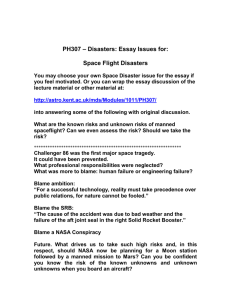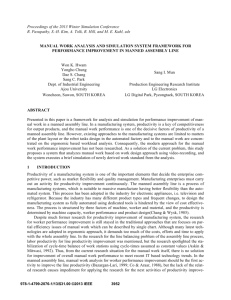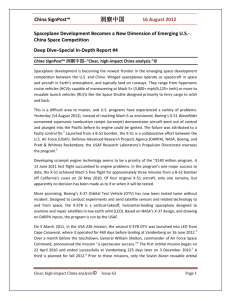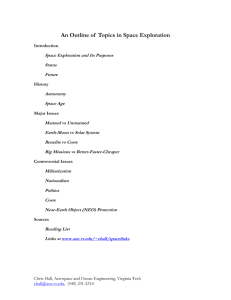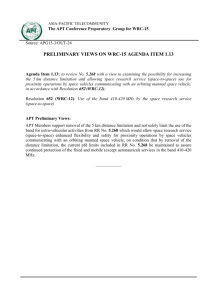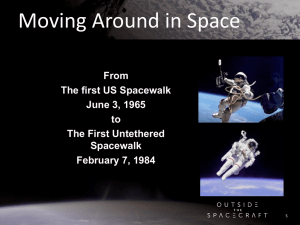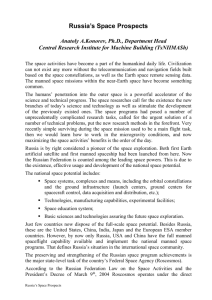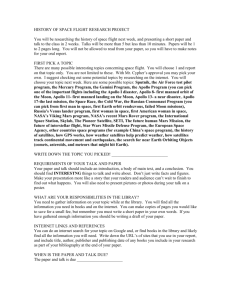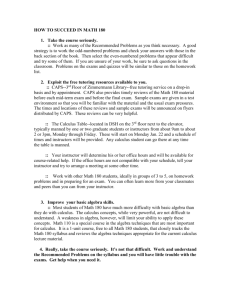Spaceplanes - Mars Society Europa
advertisement
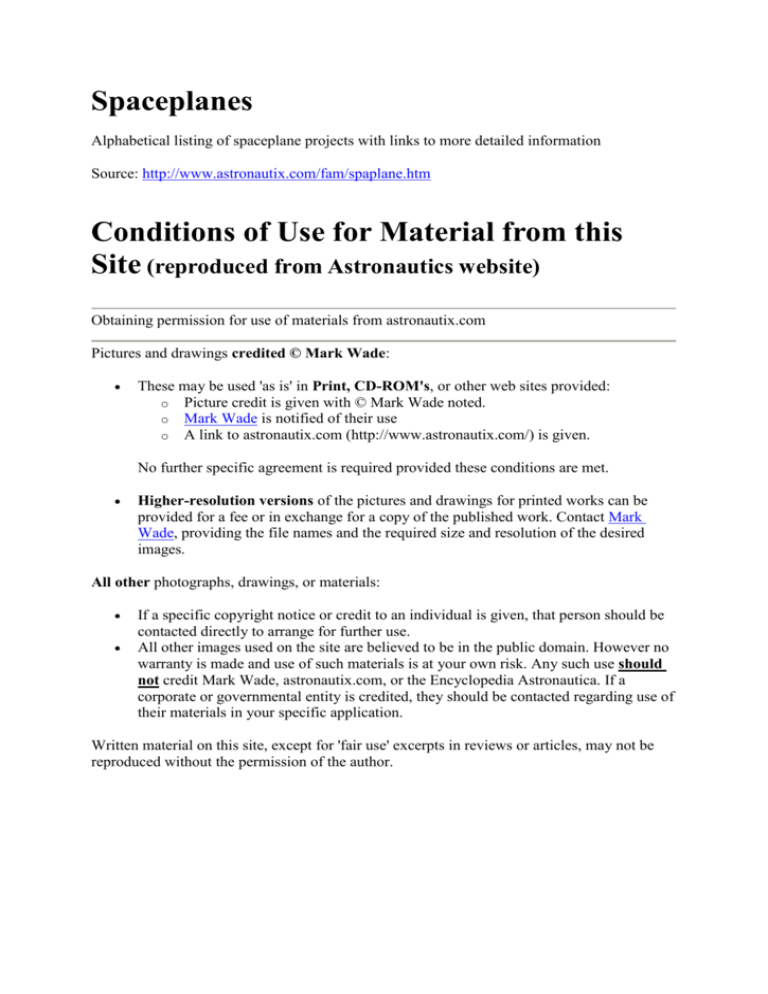
Spaceplanes Alphabetical listing of spaceplane projects with links to more detailed information Source: http://www.astronautix.com/fam/spaplane.htm Conditions of Use for Material from this Site (reproduced from Astronautics website) Obtaining permission for use of materials from astronautix.com Pictures and drawings credited © Mark Wade: These may be used 'as is' in Print, CD-ROM's, or other web sites provided: o Picture credit is given with © Mark Wade noted. o Mark Wade is notified of their use o A link to astronautix.com (http://www.astronautix.com/) is given. No further specific agreement is required provided these conditions are met. Higher-resolution versions of the pictures and drawings for printed works can be provided for a fee or in exchange for a copy of the published work. Contact Mark Wade, providing the file names and the required size and resolution of the desired images. All other photographs, drawings, or materials: If a specific copyright notice or credit to an individual is given, that person should be contacted directly to arrange for further use. All other images used on the site are believed to be in the public domain. However no warranty is made and use of such materials is at your own risk. Any such use should not credit Mark Wade, astronautix.com, or the Encyclopedia Astronautica. If a corporate or governmental entity is credited, they should be contacted regarding use of their materials in your specific application. Written material on this site, except for 'fair use' excerpts in reviews or articles, may not be reproduced without the permission of the author. List of Spaceplanes Albatros Raketoplan Russian manned spaceplane. Study 1974. Unique Russian space shuttle design of 1974. Hydrofoil-launched, winged recoverable first and second stages. More... Alflex Japanese spaceplane. Study 2000. Unmanned glider to test technology for Japanese HOPE spaceplane. Wing area 9.45 square meters. More... Alpex Japanese spaceplane. Study 2000. Kawasaki unmanned glider to test technologies for HOPE spaceplane. Wing area 7.57 square meters. More... Ames Mach 10 Demonstrator American manned spaceplane. Study 1957. Ames proposed in 1957 to air-launch a high-wing designed hypersonic glider from a B-36 bomber. Early versions would use an XLR-99-powered booster stage and be capable of reaching Mach 6. More... Ares French spaceplane. Study 1998. Small 7-meter long delta wing spaceplane, proposed by Aerospatiale, weighing 2,000 kg. Launched 2009.10.28, More... Armstrong Whitworth Waverider British manned spaceplane. Study 1960. The Armstrong Whitworth Waverider study of the 1950`s called for a two-crew waverider spacecraft powered by a second stage atop a British Blue Streak rocket. More... Asset American manned spaceplane. 6 launches, 1963.09.18 (ASSET 1) to 1965.02.23 (ASSET 6). One part of the Dynasoar manned spaceplane project was ASSET ( 'Aerothermodynamic Elastic Structural Systems Environmental Tests') . More... Astrocommuter American manned spaceplane. Study 1963. The Lockheed Astrocommuter was a 1963 design for a manned space shuttle that would use the Saturn 1B as a first stage. More... Atlantis American manned spaceplane. 33 launches, 1985.10.03 to 2011.07.08. The space shuttle Atlantis was the fourth orbiter to become operational at Kennedy Space Center, and the last of the original production run. More... Aurora X-Prize American manned spaceplane. Study 2004. X-Prize suborbital spaceplane concept of Fundamental Technology Systems, Orlando, Florida. More... Bizan Russian manned spaceplane. Study 1982. Bizan was the 1982 Soviet air-launched spaceplane design iteration between the '49' and 'MAKS' concepts. Like the '49', it was air-launched from atop an An-124 transport. More... Black Colt American manned spaceplane. Study 1993. Winged, first stage of a launch vehicle using aerial refueling and existing engines. More... Black Horse American manned spaceplane. Study 1994. Winged, single stage to orbit launch vehicle using aerial refueling and lower performance, non-cryogenic propellants. More... Blackstar American manned spaceplane. 2006 reports claimed it was flown covertly in the 1990s. More... Bono Saucer American manned spaceplane. Study 1963. In 1963 Phil Bono of Douglas Aircraft considered a lenticular configuration for a single-stage-to-orbit reusable booster. This was the largest application found to date for the lenticular concept. More... BOR-4 Russian manned spaceplane. 4 launches, 1982.06.04 (Cosmos 1374) to 1984.12.19 (Cosmos 1614). BOR-4 were subscale test versions of the Spiral manned spaceplanes. More... BOR-5 Russian spaceplane. 2 launches, 1983.07.04 (BOR-5 Flight 1) and 1984.06.06 (BOR-5 Flight 6). The aerodynamic characteristics of Buran at hypersonic speeds were validated by the BOR-5 1:8 sub-scale model of Buran. More... Buran Analogue Russian manned spaceplane. Study 1984. This Buran OK-GLI 'Analogue' was a version of the Buran spaceplane equipped with jet engines to allow it to be flown in handling and landing system tests at subsonic speed in the earth's atmosphere. More... Buran Russian manned spaceplane. One launch, 1988.11.15. Soviet copy of the US Space Shuttle. Unlike the Shuttle, the main engines were not mounted on Buran and were not reused. More... Buran The Energia-Buran Reusable Space System (MKS) had its origins in NPO Energia studies of 1974 to 1975 for a 'Space Rocket Complex Program'. More... Challenger American manned spaceplane. 10 launches, 1983.04.04 (STS-6) to 1986.01.28 (STS-51-L). More... Chang Cheng 1 Chinese manned spaceplane. Study 1988. Vertical takeoff / horizontal landing two-stage compromise design; three expendable liquid oxygen/kerosene modular boosters and a winged reusable second stage. More... Columbia American manned spaceplane. 28 launches, 1981.04.12 (STS-1) to 2003.01.16 (STS-107). Columbia, the first orbiter in the Shuttle fleet, was named after the sloop that accomplished the first American circumnavigation of the globe. More... Convair Shuttlecraft American manned spaceplane. Study 1962. Convair concept for a winged shuttle vehicle, early 1960's. More... Copper Canyon American manned spaceplane. Study 1984. DARPA program of 1984 that proved the technologies and concept for the X-30 National Aerospace Plane concept. More... Cosmopolis 21 Russian manned spaceplane. Mock-up unveiled in 2002. On 15 March 2002 Space Adventures unveiled the mock-up of their C-21 (Cosmopolis 21) spaceplane at Zhukovskiy Air Base, Moscow. More... Cosmos Mariner American manned spaceplane. Study 2004. X-Prize suborbital spaceplane concept of Lone Star Space Access, Houston, Texas. More... Discovery American manned spaceplane. 39 launches, 1984.08.30 to 2011.02.24. More... Douglas Astro American manned spaceplane. Study 1962. The Douglas "Astro" was a VTHL TSTO system designed for launching space station crews and cargo by the 1968-70 period. More... Dream Chaser American manned spaceplane. Study 2016. A six-passenger human space transport system announced in 2006 by SpaceDev, based on the ten-passenger HL-20 Personnel Launch System developed by NASA Langley in the 1980's. More... Dynasoar American manned spaceplane. Cancelled 1963. The X-20A Dyna-Soar (Dynamic Soarer) was a single-pilot manned reusable spaceplane, really the earliest American manned space project to result in development contracts. More... Endeavour American manned spaceplane. 25 launches, 1992.05.07 to 2011.05.16. Built as a replacement after the loss of the Challenger; named after the first ship commanded by James Cook. More... Energia-Buran Russian manned spaceplane. Study 1984. Article number for combined Energia (launch vehicle) - Buran (manned spaceplane) complex. See Buran for details. More... Enterprise American manned spaceplane. Study 1974. Enterprise was the first Space Shuttle Orbiter. It was rolled out on September 17, 1976. More... European Rocketplanes Category of spacecraft. More... H-2 HTOHL Chinese manned spaceplane. Study 1988. The H-2 horizontal takeoff / horizontal landing two-stage reusable space shuttle was proposed by Institute 601 of the Air Ministry in 1988. More... Hawker Siddeley Waverider-1960 British manned spaceplane. Study 1960. An ambitious Blue Streak / Waverider design study was conducted by Hawker Siddeley Aviation in the 1960's. The project was led by Peter A E Stewart, Astronautics Section, Advanced Projects Group. More... Hawker Siddeley Waverider-1971 British manned spaceplane. Study 1971. The Hawker Siddeley Waverider study of 1971 laid out a space vehicle with a waveriding airbreathing hypersonic first stage, and a rocket propelled, lifting body second stage. More... Hermes French manned spaceplane. Cancelled 1992. The Hermes spaceplane would have provided independent European manned access to space. Hermes was designed to take three astronauts to orbits of up to 800 km altitude on missions of 30 to 90 days in space. More... HGV American spaceplane. Study 1992. The Hypersonic Glide Vehicle was a USAF project discussed openly in 1987 to 1988, which may have flown as a black project in 1992-1993. More... HL-10 American manned spaceplane. 37 launches, 1966.12.22 to 1970.07.17 . The HL-10 was the favored lifting body configuration of NASA Langley in the 1960's. It reached Mach 1.86 and 27,700 m during its flight tests. More... HL-20 American manned spaceplane. Study 1988. The HL-20 was a NASA Langley design for a manned spaceplane as a backup to the space shuttle (in case it was abandoned or grounded) and as a CERV (Crew Emergency Return Vehicle) for the Freedom space station. More... HL-42 American manned spaceplane. Study 1997. The HL-42 was a reusable, lifting body manned spacecraft designed to be placed into low-Earth orbit by an expendable booster. More... HOPE Japanese spaceplane. Study 1986. Like Europe, the National Space Development Agency had big plans to develop a large carrier rocket and manned 'H2 Orbiting Plane' (HOPE). More... Horus German manned spaceplane. Hypersonic Orbital Upper Stage was part of the Saenger-II spaceplane studied in Germany from 1985-1993. It would have separated from the lower stage at Mach 6.6 and flown to orbit. More... Hyflex Japanese spaceplane. Unmanned testbed for Japanese HOPE spaceplane. More... Hyper American spaceplane. More... ILRV American manned spaceplane. Study 1968. In late 1968 the USAF Flight Dynamics Laboratory proposed its Integrated Launch and Re-entry Vehicle. This was a 1.5 stage-to-orbit concept with an external drop tank. More... Isinglass American manned spaceplane. Study 1965. CIA air-launched, rocket-powered high speed manned vehicle project of 1965-1968 that developed basic technologies used in later shuttle and reusable launch vehicle programs. More... Janus American manned spaceplane. Study 1965. This TRW design of 1965 used a unique concept - a lifting body main stage, that provided both ascent propulsion and reentry protection. More... Kehlet Lenticular Vehicle American manned spaceplane. Study 1961. Alan B. Kehlet of NASA's Space Task Group New Projects Panel, worked at NASA Langley and first conceived of his lenticular manned spacecraft design in 1959. More... Kitten American manned spaceplane. Study 2004. X-Prize suborbital rocketplane concept of Kittyhawk of Oroville, Washington. More... Kliper Russian manned spaceplane. Study 2004. The Kliper manned spacecraft replacement for Soyuz was first announced at a Moscow news conference on 17 February 2004. More... LB-X American manned spaceplane. Study 2004. X-Prize suborbital spaceplane concept of Kelly Space & Technology, San Bernardino, California. More... LII Spaceplane Russian manned spaceplane. Study 1993. LII (the Gromov Experimental Flight Institute at Zhukovskiy) designed several alternate spaceplane concepts for airlaunch from the An-225 transport. These were similar to the various MAKS concepts. More... LKS Russian manned spaceplane. Mock-up stage when cancelled in 1983. The LKS was a Chelomei design for a reusable manned winged spacecraft, similar to the later European Hermes spaceplane. More... Lockheed RTTOCV American manned spaceplane. Study 1963. In 1962 NASA funded studies with several contractors on Operations and Logistics for Space Stations. More... Lockheed Space Taxi American manned spaceplane. Study 1963. Lockheed investigated the economics of reusable launch vehicles for crews and light space station cargo during the early 1960s. Lockheed proposed a new reusable 10-man spaceplane as a follow-on to the Apollo CSM. More... Lofer Mystery Craft German manned spaceplane. Hardware construction stage, 1945. There exist in US Army postwar files a murky photo of what some think is a large-scale mock-up of the Saenger antipodal bomber, taken in Lofer, Austria after the end of the World War II. More... M1 Ames' original design for a blunt lifting body. Technical details are for single-crew version proposed in 1958 as a lower-cost alternate to Dynasoar. More... M2b Version of M2 lifting body proposed in 1958 as an alternate to the Dynasoar winged glider configuraiton. More... M2-F2 American manned spaceplane. Study 1966. The least stable of the lifting body designs. The 'flying bathtub' had a rounded belly / flat top layout as opposed to the flat belly / rounded top of the other designs. More... M2-F3 American manned spaceplane. 43 launches, 1966.07.12 to 1971.12.21 . The crashed M2-F2 was rebuilt as the M2-F3 with enlarged vertical stabilizers. Maximum speed achieved was Mach 1.6, top altitude 21,800 m. More... M-48 Russian manned spaceplane. Study 1958. In 1958 the VVS (Soviet Air Force) requested development as quickly as possible of high-speed aerospace vehicles. More... MAKS Orbiter Russian manned spaceplane. Reached advanced stage of development testing and prototype construction when project was cancelled in 1988. The MAKS spaceplane was the ultimate development of the OK-M studies NPO Molniya conducted with NPO Energia. More... Martin Astrorocket American manned spaceplane. Study 1962. Early two-stage-to-orbit shuttle study, using storable propellants, Dynasoar-configuration delta wing orbiter. More... Mayflower American manned spaceplane. Study 2004. X-Prize suborbital seaplanespacecraft of Advent Launch Services of Houston, Texas. Reached the stage of engineering tests by 2003. More... McDonnell Spaceplane 1963 American manned spaceplane. Study 1963. In June 1962 NASA funded studies with several contractors on Operations and Logistics for Space Stations. More... MiG 105-11 Russian manned spaceplane. 8 launches, 1976.10.11 to 1978.09.15 . Atmospheric flight test version of the Spiral OS manned spaceplane. The 105-11 incorporated the airframe and some of the systems of the planned orbital version. More... MTKVA Russian manned spaceplane. Study 1974. Manned lifting body spaceplane, designed by Soviet engineers as a recoverable spacecraft in the early 1970's. More... MURP American manned spaceplane. Study 1969. The McDonnell Douglas Space Shuttle Phase A studies were conducted under contract NAS9-9204. Their Class I vehicle was dubbed MURP - Manned Upper Reusable Payload. More... NAA RTTOCV American manned spaceplane. Study 1963. North American Aviation's Reusable Ten Ton Orbital Carrier Vehicle design of 1963 had as a standard payload a lenticular 12-man orbital transfer vehicle spaceplane for space station logistics and crew transfer. More... NASA ACRV American manned spaceplane. Study 1986. The early Space Station proposals assumed the facility would be equipped with a 'safe haven' where the crew would wait for a rescue Shuttle in case of emergency. More... NASA Lifting Body NASA's Ames Research Center and Langley had promoted the idea of 'lifting bodies', rounded half-cones, for use as manned recoverable spacecraft. These provided lift for maneuver and recovery at an airfield after re-entry from orbit. More... Navaho The Navaho intercontinental cruise missile project was begun just after World War II, at a time when the US Army Air Force considered ballistic missiles to be technically impractical. The Navaho required a large liquid propellant rocket engine to get its Mach 3 ramjet up to ignition speed. This engine, derived with German assistance from that of the V-2, provided the basis for the rockets that would later take Americans into space. More... Nonweiler Waverider British manned spaceplane. Study 1951. The Nonweiler Waverider of the 1950`s was the original caret wing waverider concept. Developed by Professor Terence R F Nonweiler, of Queen's University, Belfast. More... OK-M Russian manned spaceplane. Study 1984. 1980's design for a spaceplane, smaller than Buran, to replace Soyuz and Progress spacecraft for space station crew rotation/replenishment tasks. More... OK-M1 Russian manned spaceplane. Study 1984. The OK-M1 manned spaceplane was designed by NPO Molniya as a follow-on to the OK-M of NPO Energia. The OK-M1 was an integrated part of a unique launch vehicle, the MMKS reusable multi-module space system. More... OK-M2 Russian manned spaceplane. Study 1984. The OK-M2 was a manned spaceplane, a straight delta wing joined to a broad fuselage with an upturned nose. More... One alternate payload was a passenger module for 36 persons. Pathfinder American manned spaceplane. Study 2003. Pioneer Rocketplane planned in the late 1990's to produce the Pathfinder aerial propellant transfer spaceplane. More... Payload: 3,000 kg (6,600 lb). Pioneer XP American manned spaceplane. Study 2004. X-Prize suborbital spaceplane concept of Pioneer Rocketplane, Solvang, California. No backing forthcoming. More... PKA Russian manned spaceplane. Study 1959. In 1957, in response to the USAF Dynasoar project, Soviet aviation bureaus were tasked with producing draft project designs for a manned spaceplane. More... Prime American manned spaceplane. 3 launches, 1966.12.21 (Prime 1) to 1967.04.19 (Prime 3). The Prime (Precision Recovery Including Maneuvering Entry) project was the RAE Orbital Fighter British manned spaceplane. This Royal Aircraft Establishment Orbital Fighter proposal of the 1960's envisioned a two stage vehicle. A ramjet powered first stage would release a second stage orbiter similar to, but smaller than, the US Dynasoar. More... Raketoplan Russian manned spaceplane. Developed from 1959, including suborbital hardware tests, before cancellation in 1964. More... Reusable Orbital Carrier American manned spaceplane. Study 1964. The Reusable Orbital Carrier (ROC) was a 1964 Lockheed study of a sled-launched HTHL TSTO. The second stage orbiter rocketplane would use Lox/LH2 propulsion to orbit and make an unpowered glide return and landing. More... Rocketplane XP American manned spaceplane. Study 2015. The Rocketplane XP Vehicle was a proposed suborbital manned spaceplane with accommodations for four crew. More... SabreRocket American manned spaceplane. Study 2004. X-Prize suborbital spaceplane concept of Panaero, Fairfax, Virginia. It envisioned conversion of a Sabre-40 business jet to rocket power. More... Saenger I German manned spaceplane. Study 1964. MBB design for a vertical-launch, horizontal landing two-stage winged launch vehicle. More... Saenger II Proposed two stage to orbit vehicle. Air-breathing hypersonic first stage and delta wing second stage. The German Hypersonics Programme and its Saenger II reference vehicle received most of the domestic funding for spaceplane development in the late 1980s and early 1990s. More... Salkeld Shuttle American manned spaceplane. Study 1965. 1965 concept for a manned spaceplane equipped with drop tanks, which would be air-launched from a C-5 More... See also Shenlong Chinese spaceplane. Study 2007. Chinese spaceplane photographed under the belly of an H-6 medium bomber in 2007. Probably a subscale drop test model of a potential space combat system. More... Spacebus British manned spaceplane. Study 1990. 50 passenger orbiter portion of a twostage vehicle proposed by David Ashford of Bristol Spaceplanes Ltd. in the 1980`s / 1990's. More... Spacecab British manned spaceplane. Study 1990. Six passenger orbiter portion of a twostage vehicle proposed by David Ashford of Bristol Spaceplanes Ltd. in the 1980`s / 1990's. It would serve as the prototype for the even more ambitious Spacebus. More... Spaceplane Category of spacecraft. More... SpaceShipOne American manned spaceplane. 14 launches, 2003.05.20 to 2004.05.13 . XPrize suborbital spaceplane concept of Scaled Composites, Mojave, California. More... SpaceShipTwo American manned spaceplane. Study 2009. Development of the much larger SpaceShipTwo suborbital commercial manned spacecraft was announced in July 2005. More... Spiral OS Russian manned spaceplane, developed 1965-1980s, including subscale flight article tests. Evolved into the MAKS spaceplane. The Spiral was an ambitious airlaunched manned space system designed in the 1960's. More... STS The Space Transportation System (Space Shuttle) was conceived originally as a completely reusable system that would provide cheap, routine access to space and replace all American and civilian military launch vehicles. Crippled by technological overreach, political compromise, and budget limitations, it instead ended up costing more than the expendable rockets it was to have replaced. STS sucked the money out of all other NASA projects for half a century. The military abandoned its use after the Challenger shuttle explosion in the 1980's. More... System 49 Russian manned spaceplane. Study 1981. System 49 was the design that followed Spiral and preceded MAKS in the Soviet quest for a flexible air-launched manned space launcher. More... System 49-M Russian manned spaceplane. Study 1981. The 49M was an application of the system 49 air-launched design concept, but with a larger carrier aircraft. The orbiter mass was 28 metric tons in orbit, including a 9 metric ton payload in a 8. More... TAV American manned spaceplane. Developed in the 1980s but halted in favor of the X30. USAF program of the 1980's that reached the test hardware stage and was leading to a single-stage-to-orbit, rocket-powered, winged manned vehicle. More... The Space Tourist American manned spaceplane. Study 2004. X-Prize suborbital flying saucer concept of Discraft Corporation of Portland, Oregon. More... Tian Jiao 1 Chinese manned spaceplane. Study 1988. The Tian Jiao 1 (Pre-eminent in Space 1) manned spaceplane was proposed by the First Academy (now the China Academy of Launch Technology) in 1988. More... Tian Jiao 2 Chinese manned spaceplane. Study 2006. What appeared to be an evolved version of 1988's Tian Jiao 1 manned spaceplane concept was proposed by the China Academy of Launch Technology in 2006. A 2020 operational date was mentioned. More... Tsien Spaceplane 1949 American manned spaceplane. Study 1949. Intercontinental rocket transport, 5,000 km range, single stage winged design clearly derived from V-2 aerodynamics. More... Tsien Spaceplane 1978 Chinese manned spaceplane. Study late 1970s. Tsien Hsue-shen's manned spacecraft design proposed in the late 1970's was a winged spaceplane, launched by a CZ-2 core booster with two large strap-on boosters. More... Tu-2000 Russian manned spaceplane. Study 1986. In reaction to US X-30 project, government decrees of 27 January and 19 July 1986 ordered development of a Soviet equivalent. More... V-2 VTOHL Chinese manned spaceplane. Study 1988. The V-2 vertical takeoff / horizontal landing two-stage reusable space shuttle was proposed by Beijing Department 11 of the Air Ministry in 1988. More... Venturestar American manned spaceplane. Study 2006. Production reusable singlestage-to-orbit launch vehicle using technology developed in X-33 testbed. More... VERAS French manned spaceplane. Study 1968. A Mach 10 spaceplane demonstrator proposed by Nord Aviation in 1968. More... VKA Myasishchev 1957 Russian manned spaceplane. Study 1957. The VKA (aero-space vehicle) was a 1957 Myasishchev design - a diminutive single-crew star-shaped spaceplane that could be launched by Korolev's R-7 ICBM. More... VKA-23 Design 1 Russian manned spaceplane. Study 1960. Myasishchev single-pilot winged spacecraft of 1960, sized for launch to orbit by Korolev's Vostok booster. More... VKA-23 Design 2 Russian manned spaceplane. Study 1957. Following the very critical review of the first M-48 spaceplane design by the expert commission, Myasishchev went back to the drawing board. More... VKK Russian manned spaceplane. Study 1998. A Russian concept of the 1990's harking back to Chelomei's Raketoplan of three decades earlier. A manned aircraft would be protected during launch and re-entry by an expendable aeroshell heat shield. More... VKS Russian manned spaceplane. Study 1986. The Energia VKS was designed as a hypersonic rocketplane with multi-regime engines, in response to the Soviet Ministry of Defenses' MVKS single-stage reusable aerospaceplane system requirement. More... Winged Gemini American manned spaceplane. Study 1966. Winged Gemini was the most radical modification of the basic Gemini reentry module ever considered. More... X-15A American manned spaceplane. 174 launches, 1959.06.08 (X-15 Flight 1) to 1968.10.24 (X-15 Flight 199). The X-15 was the first USAF and NASA project for manned spaceflight, initiated years before Mercury. More... X-15A-2 American manned spaceplane. Study 1965. The crash-damaged X-15 number 2 was rebuilt to attain even higher speeds. The body frame was stretched, and two drop tanks were added, increasing propellant load by 75%. More... X-15A-3 American manned spaceplane. Cancelled 1962. It had been proposed that X-15 number 3 would be reworked to install a delta wing and designed to reach Mach 8. More... X-24A American manned spaceplane. 28 launches, 1969.04.17 to 1971.06.04 . The X24A was the Martin Corporation's subsonic test version of the US Air Force's preferred manned lifting body configuration. More... X-24B American manned spaceplane. 36 launches, 1973.08.01 to 1975.11.26 . More... X-24C American manned spaceplane. Cancelled 1977. Two X-24C NHFRF (National Hypersonic Flight Research Facility) aircraft were to be built under a $ 200 million budget. More... X-30 American manned spaceplane. Study 1990. More... X-34 American spaceplane. Study 1996. More... X-37 American unmanned spaceplane. The Boeing X-37 Space Maneuver Vehicle began as a subscale version of a proposed USAF manned 21st Century spaceplane. The smallerscale X-40 tested some technologies prior to completion of the X-37A. The X-37B was the operational reusable space vehicle. Operational, first launch 2010.04.22. More... X-38 American manned spaceplane. 2 launches, 1972.02.16 (HL-10 LB Test?) to 1972.05.20 (HL-10 LB Test?). Lifting body reentry vehicle designed as emergency return spacecraft for International Space Station crew. More... X-40 American spaceplane. Study 2001. Boeing X-40A Experimental Space Maneuver Vehicle was built to test landing technologies for the later X-37. More... X-43 American spaceplane. Study 1997. NASA's X-43 Hyper-X program demonstrated an integrated hypersonic scramjet engine briefly at Mach 10 on its third and final flight. More... Xerus American manned spaceplane. Study 2016. Suborbital vehicle that XCOR planned to design and build on a commercial basis. Rocket powered, it would take off from a runway, and be capable of high altitude, high speed flight. More... Yakovlev MVKS Russian manned spaceplane. Study 1986. In reaction to US X-30 project, government decrees of 27 January and 19 July 1986 ordered development of a Soviet equivalent. More...
